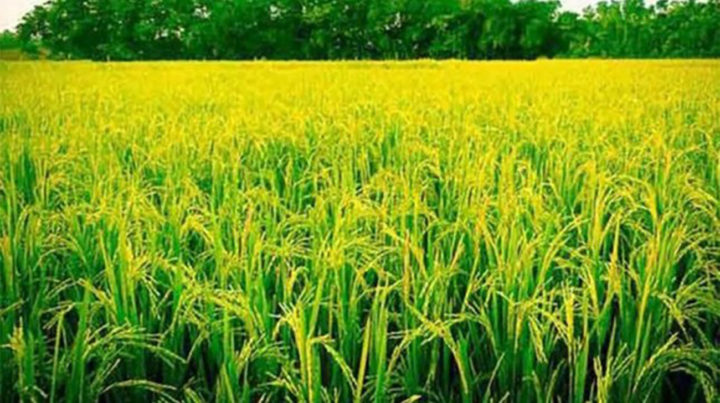Govt moves to introduce new farming techniques
People living by the Kirtonkhola river in Barishal noticed in March this year that the river’s water had become unusually salty.
After an electrical conductivity test, Department of Environment officials confirmed what the locals have been saying.
They said the sudden rise in salinity may have been caused by reduced water flow from upstream and lower rainfall.
The Kirtonkhola is now another in a list of over 100 rivers flowing through the coastal region and affected by salinity due to sea water intrusion.
Saline river water also results in salinity in the groundwater which in turn increases the level of soil salinity. And that causes a significant reduction of vegetation in the affected areas, experts say.
Around 25-30 percent of the country’s arable land is located in 21 coastal districts, of which 53 percent has become saline-affected, finds a recent study by Khulna University.
According to the study, around 75 percent of land in Satkhira, 66 percent in Bagerhat, 32 percent land in Khulna, and 72 percent in Barguna are affected by salinity.
In a study by the government in 2009, salinity-affected areas increased to 1.05 million hectares from the 0.83 hectares found in the previous government study in 1973.
The 2007 report of the Intergovernmental Panel for Climate Change (IPCC) said rice production in Bangladesh may fall by 10 percent and wheat production by 30 percent by 2050.
But seawater intrusion into the country’s river system seems to be leaving an impact on the coastal region that is much worse than forecast by the IPCC.
While farmers in other parts of the country are cultivating up to four crops a year, farmers in the coastal region are hardly able to cultivate a single one.
“Twenty-five percent of the country’s arable land is in the coastal area, which has become saline. In most of the saline-prone areas, either people do shrimp farming or cultivate transplanted Aman rice. But now we are encouraging farmers to cultivate saline-tolerant alternative crops if they cannot grow rice,” said Agriculture Minister Muhammad Abdul Razzaq.
“In a country with only 10 decimal agricultural land per capita, you will find miles after miles of barren land in the coastal area, and that is a major setback for the country,” the minister said.
But the country is gradually trying to adapt to the situation.
Scientists from Bangladesh Rice Research Institute (BRRI) have developed some rice varieties that can be cultivated in saline-prone areas.
“Our scientists have developed BRRI 67, a saline tolerant variety which will be very successful,” the minister said.
Along with this saline tolerant variety, the minister said, “We will encourage them [local farmers] to cultivate alternative crops”.
People from Patuakhali did not know how to cultivate mung beans. But for the last few years, they have been cultivating mung beans, a very good alternative crop, the minister said.
Local agricultural offices in coastal districts have taken some initiatives of farming alternative crops, the minister said.
“Once the pandemic is over, we will take up a special programme to encourage alternative crop farming along with saline tolerant rice varieties,” the minister said.
WATERMELON AND VEGETABLES BRING NEW HOPE
Kamal Bawali of Bhulbaria village under Khulna’s Dumuria upazila, a saline-prone area, used to cultivate Aman paddy on his two bighas of land. But he hardly made any profit due to the low yield of local Aman variety.
But Kamal’s fate changed last year as he and a few other farmers received preliminary training and guidelines from a local agriculture officer on how to cultivate crops in saline-prone areas.
After learning the method last year, Kamal cultivated watermelon on his land. He grew around 800 watermelons on one bigha. This year he cultivated even more on a total of five bighas of land.
He spent Tk 56,000 to cultivate watermelons. In a bumper harvest, he earned a profit of around Tk 3 lakh from watermelons this year.
Rabiul Islam Robi, union parishadchairmanof Sharifpur of Dumuria, told The Daily Star that people of the region used to put all their hopes on salt-water shrimp (bagda) farming.
Farmers had tried to grow vegetables and sowed seeds many times, but it used to be damaged due to the effect of saline water and it was not possible to produce vegetables or other crops here, he said.
But now, farmers are growing watermelons, wheat, maize, and winter vegetables from their land using rainwater.
Many people migrated from the area as they lost their livelihoods. But now the method of digging small ponds to preserve fresh water for irrigation to produce vegetables or other crops have raised hopes in Dumuria, Batiaghata, Dacope, Paikgacha upazilas of Khulna district over the last couple of years, the UP chairman added.
THE FARMING METHOD
Farmers store rainwater by digging small ponds in a portion of their land for irrigation of crops. Later they apply potash, gypsum and organic fertiliser on the land as per the rules taught by agricultural officials to grow crops.
Using this method, thousands of farmers in saline-prone areas of Khulna have revolutionised agriculture, said GM A Gafur, additional director of Department of Agricultural Extension (DAE) of Khulna region.
Mosaddek Hossain, Dumuria upazila agriculture officer, told The Daily Star that all of Magurkhali union and many parts of Sharafpur and Shobhana unions were once saline-prone areas fit only for shrimp cultivation.
“Using freshwater from rainwater and using 20 kgs of potash, 15 kgs of gypsum and organic fertilisers, farmers are now producing multiple crops,” he added.
This has brought a radical change among farmers. They are now cultivating Aman, Aush, corn, watermelon, potato, onion, eggplant, gourd, tomato, pumpkin, bean, long bean, red amaranth, cauliflower, gourd, radish, etc.
According to the DAE, about 6,000 tonnes of vegetables are being produced in just these three unions. In the last three and a half years, 2,500 hectares of land – 75 percent of cultivable land — has come under agricultural cultivation in the unions through a joint venture of farmers and the Department of Agriculture.
Officially, 2,000 farmers are being trained in saline-prone areas. DoAare also providing seeds to those farmers at free of cost.




